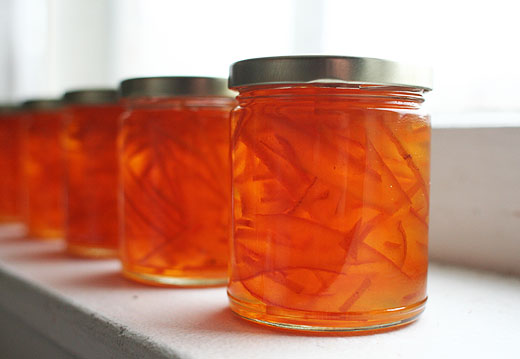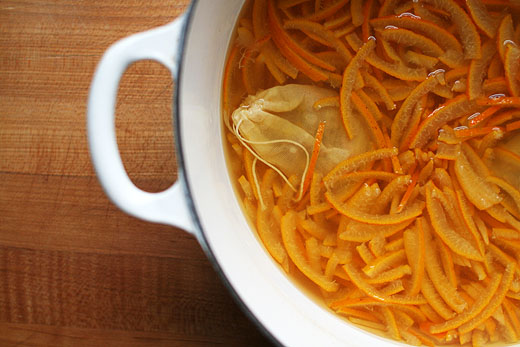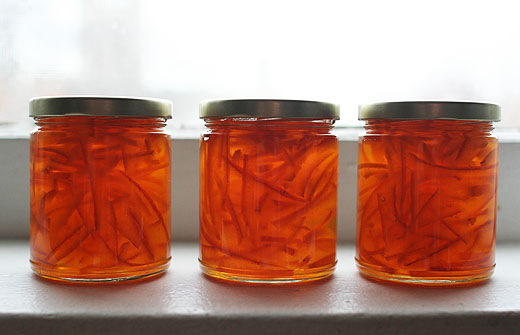
A few weeks ago Luisa wrote about some beautiful bitter orange marmalade she made. I usually do whatever Luisa tells me, and I’ve been wanting to make marmalade for years, so I started checking around to see if I could find me some Seville (sour) oranges in Chicago. I found folklore-like reports online of sightings at this ethnic market or that grocery store…but nothing panned out. I started to give up and move onto other projects. But while we were in Los Angeles, some friends who took us to Lindy & Grundy, a super rad butcher shop in West Hollywood. I picked up a jar of orange marmalade that turned out to be fantastic and renewed my determination to find the oranges. I found a place online where I could order a case of Seville oranges, and despite the high cost, decided that the elusive Seville oranges would be mine.

The marmalade I bought in LA was made by the talented Kevin West who writes about preserving on his beautiful blog Saving the Season (he’s also about to publish a cookbook). It was an extremely delicious marmalade, “strong marmalade” as he calls it—sweet, bright, bitter, oily. The recipe was published on his site (and another version of it in the current issue of Lucky Peach). I gave it a try so that you’d have a couple of recipes to choose from if you find yourself some Seville oranges.

Preserving fruit remains my all-time favorite kitchen activity (ice cream making might be a close second). There is magic that happens when you turn fruit into jam. Seville oranges ain’t joking. They are very, very bitter. Like, inedible. They require cooking, soaking, and lots of sugar to fight that bitterness. This particular marmalade is perfect because it retains a lot of that bitterness. It isn’t for everyone, but it is for me in the most serious of ways. Also, look at it! It could not be prettier. The jars remain on my window ledge for me to admire. It is great on toast, but also nice on a bowl of vanilla ice cream.

My version below is an adaptation of the Kevin West recipe. I leave the processing up to you, folks have different opinions on how to safely can fruits and I don’t want get involved in that discussion right now. There is plenty of information online.
Seville Orange Marmalade (recipe adapted from Kevin West)
- 3 pounds Seville oranges
- 2 quarts water
- 3 pounds granulated sugar
Scrub the oranges well in cold water. (If you’re using oranges that have been waxed, use hot water to scrub and remove all traces of wax.)
Put the whole oranges and water in a large pot. Bring to a boil, cover, and cook at a lively simmer for 70-90 minutes, until the peels are soft and the fruits have started to deflate a little.
Remove the cooked oranges with a slotted spoon and transfer them to a rimmed baking sheet or large platter to cool. Measure the remaining cooking liquid. You want to have around 6 cups, so add or subtract water to reach the correct amount. Transfer the 6 cups of cooking liquid to a large bowl.
Once the oranges are cool enough to handle, halve them and scoop out the seeds and pulp. Pick through the pulp for seeds and place them into a small muslin bag, or a pouch made from a double-thickness of cheesecloth. You don’t need to be too careful with this, no need to clean off bits of pulp or find every single seed. Add the bag of seeds to the bowl of liquid.
Cut each half peel into quarters and then each quarter into thin strips. Add to the bowl of liquid. Cover the bowl tightly with plastic wrap and let sit at room temperature overnight.
The next day, squeeze the bag of seeds to extract as much pectin-y liquid back into the bowl of oranges at possible. Discard the seeds. In a preserves pan, or large dutch oven, combine the sugar and oranges with their liquid. Bring the mixture to a boil while stirring to dissolve sugar. Cook at a moderate boil, stirring regularly. After 40 to 60 minutes (may be longer or shorter depending on heat and oranges) the marmalade will turn glossy and darker. Check for a gel set by placing a teaspoon of the preserve on a chilled saucer in the freezer for one minute. If the puddle of cooled marmalade has formed a skin and wrinkles a bit when you push on it, it is done. If not, keep cooking for another couple of minutes and test again.
Remove pan from heat and ladle marmalade into prepared jars. Because of the high amount of sugar and acid, Seville orange marmalade has an especially long shelf life, 18-24 months.
I got 7 8-ounce jars out of this recipe.



Luisa says:
March 21st, 2013 at 10:00 am
Yes!!! So glad you made and loved this. And I love the sound of Kevin’s marmalade. I’ll be trying this method next February, can’t wait! xx
Katie says:
March 21st, 2013 at 10:23 am
So beautiful!!
I was really, really tempted to order some oranges too when I saw the recipe in LP, but I already have too many fingers in too many different pots as is. I am waiting patiently now for quince season, so that I can try out the other Kevin West recipe from that issue.
Dena says:
March 21st, 2013 at 10:58 am
Looks lovely and fragrant. I can smell the aromas of the marmalade simmering on the stove…And I bet this would taste AMAZING on those English Muffins you encouraged us to make a few posts ago. YUM. Time to get back in to the kitchen. Thank you, again, for the inspiration.
SG says:
March 21st, 2013 at 2:23 pm
these photos are elevating me into another sphere. the color! you have such a lovely way with arranging. xo
Luisa says:
March 21st, 2013 at 2:32 pm
So perfect… I already have three jars of blood orange marmalade I made a couple of weeks ago. But, I must try this recipe real soon! Thanks for sharing! :)
ami@naivecookcooks says:
March 21st, 2013 at 2:50 pm
Wow! I remember how my mom used to make these a lot!
Laura@howtocookgoodfood says:
March 21st, 2013 at 3:58 pm
I made my first Seville orange marmalade this year too. I entered it into The Dalemain marmalade awards in the UK which has a thousand or two entries. I got a bronze award and was delighted! I added some Campari & ginger to it. Yours looks like it would have done very well indeed. Such an addictive thing to make :))
ItalianGirlCooks says:
March 21st, 2013 at 4:50 pm
What beautiful jars of orange marmalade…I can just imagine it on your English muffins. Yummy.
Alla says:
March 21st, 2013 at 5:17 pm
Really nice indeed! I’ve got a question though.
Where did you get these nice jars and are they processable?
Playin with my Food says:
March 22nd, 2013 at 5:23 am
I love making marmalade and this one looks scrumptious . Where did you find those elegant canning jars?
Quinn Cooper says:
March 22nd, 2013 at 5:52 am
I’m really interested by this recipe because I’ve never heard of Seville oranges and I have no idea there was an orange that was so bitter it was almost inedible. I’m sure it gives quite a unique flavor to the marmalade. I definitely want to give this recipe a shot. DOes anyone know if you can buy these oranges at your local grocery store.
Tim says:
March 22nd, 2013 at 5:59 am
Hi y’all- The jars are from Specialty Bottle. I didn’t process these in a water bath, so I can’t speak to that.
Chef Connie @ marinatingonline.com says:
March 22nd, 2013 at 8:38 am
So very beautiful. I will need to make this recipe.
robyn @ the freckled pie says:
March 22nd, 2013 at 11:40 am
your blog is fabulous. and orange marmalade always reminds me of my grandmother virgina… i’ve aways wanted to make my own for this one recipe i’ve seen before dubbed sunshine cake. thanks for the recipe and inspiration. is there any color happier than orange?
la domestique says:
March 22nd, 2013 at 11:55 am
The marmalade is absolutely gorgeous! I am a big fan of (balanced) bitter flavors and shy away from preserves that are too sweet. Looks like this is right up my alley! So glad you mentioned Kevin and his blog- I will enjoy following his kitchen adventures too!
Alan says:
March 22nd, 2013 at 3:49 pm
I am a resident of Florida but have never ventured into making orange marmalade. I am starting to get more adventurous with my recipes, growing my own veggies and the like, so maybe this is a good next step for me… although I may stick more to the sweet variety. Thanks!
explodyfull says:
March 23rd, 2013 at 3:17 am
I am not a fan of marmalade but yours looks so pretty with the orange slices suspended in the jam.
Greg says:
March 24th, 2013 at 10:58 am
Just beautiful! A gorgeous gorgeous result.
Louise says:
March 25th, 2013 at 9:22 am
As the food historian, I can tell you old canning methods that will make your eyes roll. Mrs. Sarah Rorer’s 1912 “Canning and Preserving” includes the use of formaldehyde. :-)
elizabeth madden says:
April 2nd, 2013 at 1:13 pm
solid. gorgeous. love.
Val ward says:
May 26th, 2013 at 11:08 pm
I have two Seville orange trees that produce hundreds of oranges each year. If you pay for shipping you can have as many as you want for free. I’m always looking to give them away. Have made marmalade and its great.
Katie says:
June 14th, 2013 at 8:13 pm
I’m sorry, I’m not clear what you do with the pulp. Do you just discard it and use only the boiling liquid and peel?
Tim says:
June 14th, 2013 at 8:39 pm
You don’t need to be sorry, Katie. Just discard the pulp after you have removed the seeds.
Ann says:
November 15th, 2013 at 4:23 am
If you process sealed jars (10 minutes for half-pints, 15 for pints) in a boiling-water bath, the shelf life for Seville marmalade can be way longer; the color darkens & the flavor gets richer over time. An English friend wants the jars that have been left at the back of the shelf for a few years — & has taken them home to her family in England, to their approval (that’s got to be the real test). Worth the extra few minutes it takes to do the boiling-water bath. And a shot of Scotch at the end, after it sets, is luscious too.
Willii says:
January 14th, 2014 at 6:14 pm
I just made this (a year late…whatever!). Mine isn’t nearly as pretty but still very good. It is more brown than orange. I wish it turned out as gorgeous as yours but I’m extremely happy with the amazing flavor. My oranges were very green to start, they got became more orange as I cooked but I never achieved that marvelous color. I’m a very visual person so the color is a disappointment. But that sweet bitter flavor is indeed special.
Willy says:
January 15th, 2014 at 12:21 pm
Does an open jar of this marmalade need to be refrigerated? I like it better at room temp but I can’t find any consistent answers to this question online. It seems like the sugar and the acid should make it relatively safe but I don’t have enough experience canning to feel confident.
Tim says:
January 15th, 2014 at 12:45 pm
Hi Willy- most people recommend refrigeration of any opened jars of preserves. I keep mine in the fridge and take some out the night before I might need it so it gets to room temperature- I agree that is best at that temp.
Pete Spyke says:
June 14th, 2014 at 1:23 pm
I was browsing google images and ran across the one of the Seville Oranges in a tray, and recognized it as our fruit! We’re so happy that we’re able to provide fruit that brings such pleasure and joy. The Orange Shop is one of the only places where you can obtain Seville Oranges during their season each year from November through March, shipped anywhere in the country. They’re out of season in the summer, but one secret is that if you’re making marmalade or pies, you can freeze the fruit whole and it will still be good when you’re ready to use it. By the way, in regards to the question about the pulp and juice, don’t let it go to waste! It makes the most awesome Sour Orange Pie — just search for the simple recipe, and you can whip one out while you’re waiting for the marmalade to cool. We think it’s way cool when we hear stories such as this one. Thanks! Pete Spyke
les collines says:
February 23rd, 2015 at 1:15 pm
Hello,
Lovely site!
Just wondering about your adaptation of the Kevin West recipe– he does not soak overnight, you do. Did you have trouble with the set with his recipe?
Many thanks–
Tim says:
February 23rd, 2015 at 1:30 pm
Sometimes he does soak it overnight: http://luckypeach.com/recipes/seville-orange-marmalade/ He has a few versions of the recipe floating around. I thought it made the cooking process faster. He addresses it (sort of) here: http://www.savingtheseason.com/journal/seville-orange-marmalade-1.html
James Spencer says:
October 21st, 2015 at 10:16 am
I have been making marmalade, both in England and here, for about 40 years. The key flavour changer is the sugar. It’s great with all white, but even better with 3/4 white and 1/4 of some sort of brown (light brown, dark brown, molasses,muscovado or whatever you fancy). Different types give different flavours n pick one you like. My view is that more than 1/4 brown is OTT, flavour-wise. Try adding ginger, coriander seeds n the options are endless. If you use a pressure cooker(15 b) and cut the oranges in half, takes 45 min to bring the skin to the right tenderness. That way, you can get a production line going, making the marmalade from the first batch while the next is in the pressure cooker. I have found marmalade over 10 years old – still excellent. No need to put it in the fridge – I have never seen mould on home-made marmalade.
Gisela Barnard says:
February 7th, 2016 at 9:09 am
I bought Seville oranges some of which are still green. Can I use all of it or do I need to discard the green parts?
Helga Stachow says:
February 11th, 2016 at 12:06 pm
Hi Tim,
This is Helga from Hamburg in Germany. For the third year in a row I have been making marmelade following your recipe (and then putting the marmelade into very hot jam jars with twist-off lids). Time for a feedback: DELICIOUS, BEAUTIFUL! EASY! Very popular with family and friends… We are lucky here in getting non-waxed Seville oranges from Spain in wholefood shops. SO: thank you very much for this recipe! And, of course, for your site.
Kelly says:
March 23rd, 2016 at 9:16 am
Does anyone have a source for Seville oranges in the U.S.? MaMade is pretty good, but I want to make the marmalade from scratch.